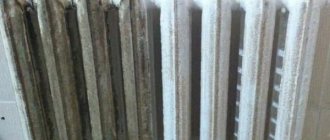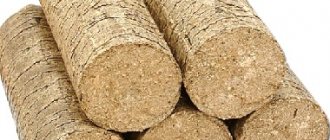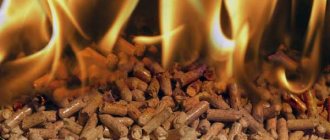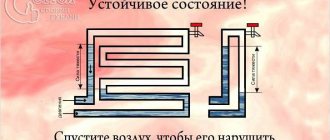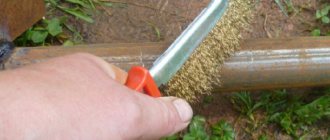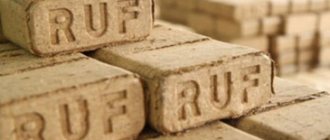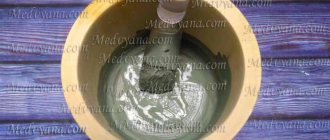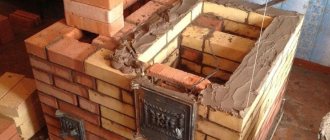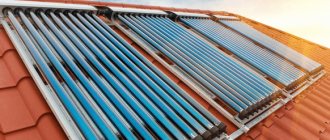How to get maximum benefit?
In order for fuel to retain its calorific value, it must be stored properly.
Although it is profitable to purchase coal in large quantities, you should not do this for several years in advance. The most unstable to storage is brown; it will last up to six months without loss of properties; anthracite has the longest shelf life, up to one and a half years. To store coal, choose a dark, well-ventilated place protected from moisture in a basement or shed. Fuel is placed in specially made wooden boxes or stored in bags.
Photo 4. Bag of coal. It is best to store coal fuel in such packaging.
Coal reserves are not afraid of precipitation, so they can be left in the yard. For such storage, choose a compacted area, pour coal on it, and compact it to reduce the air content, which promotes oxidation.
Storage conditions for fuel briquettes
The clear shape and high density of the fuel blocks allows for a small storage area. On one cubic meter you can carefully stack up to two and a half tons of briquettes for the stove. In this case, the required level of environmental humidity should not exceed more than 80%.
It is not necessary to build a special room; compressed fuel can also be stored under a canopy. The main thing is that no moisture gets on it, and air circulates around it. Pressed husk fuel is considered to be the most vulnerable to moisture.
There are no harmful fumes coming from it. Not subject to spontaneous combustion. It practically does not absorb moisture from the air due to its high density. Therefore, performance properties are maintained for a long period of time.
Types of fuel for long-burning furnaces
Types of fuel for a pyrolysis furnace.
The well-known long-burning wood-burning stove is a fairly universal unit and can work not only on chopped logs. There are quite a lot of energy carrier options that can be used in factory models of pyrolysis furnaces, not to mention home-made designs that work on almost everything. So, energy options:
Long-burning coal stoves for homes, along with wood stoves, are most often used. This is primarily due to the cost of fuel, although the difference ultimately turns out to be not so significant. There are many factors that do not depend on us. We will talk about this a little later, considering each of these energy carriers separately. They also read about how to make a long-burning furnace for mining.
Pellets for pyrolysis stoves are rarely used; they are mainly used in the firebox of classic solid fuel boilers. where there is a special tank with a dosed supply of fuel. Storing pellets requires more attention than storing firewood. When moisture gets on the pellets, they simply crumble, turning into an ordinary pellet. They are made from sawdust, straw, peat, waste paper or sunflower husks. There are white, gray and dark brown pellets, depending on the variety. The higher the grade, the lighter the fuel. The ash content also depends on the variety. In light pellets it is only 0.5%, which is very little. Their specific heat of combustion is a maximum of 4300 kcal/kg.
Long-burning coal stoves for home use briquettes very readily. There are several types of briquettes:
- from wood waste;
- from coal;
- from peat;
- from sunflower husks.
You should not heat a long-burning solid fuel stove with peat briquettes. The smell of smoke is so “fragrant” that neighbors may stop smiling when they meet. The stench of peat permeates the entire yard.
Wood briquettes have a fairly low humidity compared to firewood. It is no more than 10%. During combustion, 4400 kcal/kg of thermal energy is released. One briquette smolders for about four hours. Coal briquettes are compressed coal dust. When burned, they release 5200 kcal/kg of thermal energy and can smolder for up to 10 hours. Also, such products have quite acceptable ash content, which is 28%.
With thermal energy, everything is simple - the more heat one kilogram of fuel emits, the better. But with the percentage of ash content it’s the other way around.
The latter is of utmost importance for a long-burning solid fuel stove. What is ash content? These are impurities in solid fuel that do not burn and remain in the form of ash. It not only falls into the collection tank, but also settles on the walls of the stove and chimney
The normal limit for the ash content of coal is from 1 to 15%, this is if non-combustible particles are dispersed dispersed in the organic structure of coal, the so-called internal ash
It not only falls into the collection tank, but also settles on the walls of the stove and chimney. The normal limit for the ash content of coal is from 1 to 15%, this is if non-combustible particles are dispersed dispersed in the organic structure of coal, the so-called internal ash.
If the particles are of inorganic origin, the so-called external ash, then the ash content of coal can reach 60%. Ash content is an indicator of the quality of the energy carrier. It affects not only the efficiency of fuel combustion, but also increases transportation costs for delivery, since it is useless, even harmful, ballast. Because of these particles, coke is formed, which clogs long-burning coal furnaces.
How to make an electric boiler for heating a house with your own hands so that you don’t get electrocuted during operation?
The function of a stabilizer for an electric heating boiler is described here.
What are the types of pellets for a boiler?
The type of granule depends on the material from which it is made. This pellet gets its name from:
- Wood;
- Coal;
- Peat;
- From the remains of vegetation;
- Straw;
- Corn;
- From bird droppings (chicken);
- Based on waste paper;
- From solid household waste.
Wood waste pellets for boiler
The most popular and consumed product. To make pellets of this type, both coniferous and deciduous trees are used. Any waste obtained from the woodworking process is suitable as a raw material:
- Wood sawdust;
- Shavings;
- Sawdust;
- Pieces of scraps;
- Gorbyl.
“White” pellets, made from wood without bark inclusions, have the lowest ash content, which is why they are highly valued. “Grey” wood pellets, which contain bark, are mainly used for powerful boiler houses. They are relatively inexpensive and have a higher ash content.
Coal dust granules
Unlike wood pellets, where particles are retained by natural resins, coal granules are pressed in a special way, with the addition of a binder. The method is called spiral pressing.
The result is solid fuel suitable for use in any pellet boilers. One of the advantages of such a material, in addition to its high calorific value, is its good transportability - coal pellets are not prone to crushing during transportation.
Peat boiler granules
Peat pellets contain pure peat and retain their shape due to internal binders that are activated by compression. They are fragile, so their diameter cannot be small and reaches a size of 12 mm. This type has high energy intensity and is economical to use. For example, if you burn a ton of material, the heat will be released exactly as much as when burning 475 cubic meters of natural gas, 1.5 tons of wood or 500 liters of diesel fuel.
Pellets from plant residues
Another name for such fuel is agropellets. They look brown in color; the raw materials are agro-industrial waste, namely buckwheat husks and sunflower husks.
Due to the fact that the source material contains particles of sand, earth, dust and other non-combustible components, agropellets have a high ash content. Its use is justified only for heating industrial enterprises. The price here is much lower if you take other material for comparison.
Straw pellets
In terms of density and calorific value, they are equal to wood pellets. They are cheaper, but have a high ash content of up to 5.5%. After pressing, the granule is resistant to moisture penetration, which has a positive effect on the ability of the fuel not to deteriorate during storage.
Corn stalk pellets
Although corn stalks can be classified as agro-sphere products, pellets made from them are fundamentally different from agropellets due to the relatively low ash content, which is only 2.6%. Additional advantages include very long burning, high density and calorie content. Due to its light weight, this product is easy to pack, load and transport.
Pellets based on chicken manure
Poultry manure pellets can be used twice as fuel and granulated fertilizer. Due to high humidity, the raw materials are first dried in special rooms, and then crushed and pressed.
Such pellets contain many non-combustible inclusions; they are not suitable for use in private boilers due to their high ash content. It is most practical to use the product as a fertilizer - the droppings absorb moisture well and gradually release it to the roots of the plants.
Paper pellets for boiler
To obtain granules from waste paper, a more complex technological process is used. Unlike any other raw material, before pressing paper, it must first be moistened.
Advantages and disadvantages of the product
Sellers of coal briquettes insist that the calorific value of their product is significantly higher than that of other types of fuel. This may be true, since the heat of combustion of 1 kg of anthracite is 8 kilowatts, and firewood and wood-based briquettes emit up to 5 kW/kg. The advantages of briquetted coal also include:
- enlargement of particles of the initial fraction;
- reducing the volume of harmful emissions into the atmosphere during combustion;
- high quality products with standard indicators;
- ease of storage and transportation;
- ease of spending control;
- combating spontaneous combustion of fine coal;
- environmental cleanliness and absence of harmful chemical additives;
- high heat transfer;
- ease of ignition and burning duration.
https://youtube.com/watch?v=jgT9fpwDmZw
However, owners of solid fuel boilers cite a number of reasons for the low popularity of coal briquettes in comparison with their wood counterparts. The disadvantages include the following:
- the equipment is difficult to heat, and the fuel does not provide enough heat;
- when burning in the premises there are unpleasant odors;
- products crumble freely and become shapeless during transportation;
- A large amount of ash is formed.
Negative reviews are understandable if we remember that unscrupulous manufacturers, in order to obtain maximum profits, try to use charge, sludge and other coal products that are unsuitable for heating needs. Real anthracite briquettes with a rich black glossy color are difficult to find on sale. This leads to the logical conclusion that it is preferable to make coal briquettes yourself and purchase high-quality raw materials for this.
You should not waste effort and money on pressing low-calorie types of coal, although such briquettes, in proper combination with firewood, will significantly reduce overall costs during the heating season. Manufactured using a homemade method, they differ unfavorably from factory-made analogues: they produce little heat when burning, are fragile and are destroyed during transportation. But here it is possible to take care of the quality of the source material and adjust the content of additives. And the cost of homemade bricks, pillows and sausages turns out to be much more attractive than the prices of their factory-made counterparts.
Do-it-yourself briquetting - pros and cons
It is possible to make a press yourself and set up the production of fuel briquettes. But this requires material costs, physical effort and time. It is also necessary to take into account that it is unlikely that it will be possible to achieve the quality of European firewood produced in factories. Of course, you can purchase a machine that is not much inferior to a production one, but the acquisition costs will be colossal.
You need to have a good idea of why you need your own production, what the conditions are for this, and what the costs will be. Maybe you shouldn’t give up regular firewood or it might be better to buy ready-made briquettes for heating.
pros
The positive aspects of homemade are as follows. Your own fuel briquettes will not provide the same combustion quality as purchased briquettes, but they will be more efficient than firewood.
If it is possible to obtain a large amount of wood waste - sawdust, small trimmings, shavings, bark - then it is more profitable to make compressed firewood from them. Sawdust and shavings in their pure form are of little use for combustion, but after processing on a sawdust pressing machine they produce good fuel.
You can use not only wood, but also any other combustible waste - straw, dry leaves, paper, cardboard. Separately, none of them are flammable material, but briquettes will be useful. Briquetted fuel is convenient for storage and loading into the firebox.
Minuses
But there are also disadvantages to keep in mind. Attempts to improve the quality of home-made European firewood can lead to the purchase of expensive equipment or the constant addition of existing equipment. As a result, it turns out that producing your own briquettes will not justify the costs.
Homemade fuel briquettes require space for proper drying. Drying in the sun is not always justified. A spacious, dry room is required. Homemade briquettes should also be stored so that they do not absorb moisture.
Homemade Bonding Materials
Using homemade machines, it is almost impossible to achieve the pressure at which lignin is released from wood pulp. Therefore, it is necessary to add materials to the raw materials for independent briquetting that will help bind and glue the raw materials into a monolithic briquette. Most often used for these purposes:
- clay. Volume proportion 1 to 10 wood raw materials;
- glue. Any will do, but, naturally, it’s better to take the cheapest one;
- shredded paper or cardboard. In addition to the fact that it is also a flammable material, paper contains lignin. And paper lignin exhibits its adhesive properties when soaked. True, then you will need additional time to dry the briquettes containing paper.
In order for binding additives to fully demonstrate their properties, they must be thoroughly mixed with combustible raw materials, and then this mixture must be soaked in water.
This is the main difference between homemade ones. Fuel briquettes are dried after pressing so that they harden, hold their shape and burn well.
Popular manufacturers of coal briquettes
Let's get acquainted with the largest Russian companies that specialize in the production of briquetted coal fuel.
- Shalash North-West LLC
(Fedorovskoye). The products of this company are intended for use in stoves/fireplaces of country houses. In addition, these briquettes can be used in solid fuel heating devices with manual fuel loading. Typically, any available means can be used for ignition. - LLC "UK Sakhalinugol"
(Moscow). A fairly large company that is constantly growing and developing. Briquetted coal from this manufacturer is of fairly high quality, which is why it enjoys some popularity among consumers. - LLC "Coal Technologies of Siberia"
(Novokuznetsk). The products of this company can be used not only as municipal fuel, but also in the production of coke or for the production of smokeless fuel.
LLC "Zhariki"
(Novosibirsk).
It is also engaged in the production of coal briquettes, which have already found their buyers. 5. LLC "Kuzbasskaya FEC"
(Novokuznetsk). The company supplies the market with briquetted coal fuel, which, in addition to the advantages described above, also helps to effectively solve the issue of recycling fines.
This is not a complete list of domestic enterprises involved in the production of coal briquettes, however, for a general acquaintance with the issue, the information provided is sufficient.
Industrial production
For the production of industrial briquettes, the following binders are used:
- oil bitumen mixture;
- cement;
- lignosulfonate additives;
- liquid glass;
- molasses.
To process small particles of coke and some other types of coal, cement and also liquid glass are often used. Such materials are used mainly in metallurgy, where the use of these substances is permitted.
Coal tar with petroleum bitumen is also used for the production of industrial coal briquettes. They cannot be used to heat residential buildings, as they release large amounts of benzopyrene and other toxic elements prohibited by the SES.
Manufacturing technology and scope
After processing natural raw materials, a large amount of waste remains. For example, in the woodworking industry these are shavings, sawdust, and wood chips. Each production strives for a waste-free operation scheme, so they have long learned to use even leftover raw materials to make the necessary products, for example, chipboard. With the rise in price of solid fuels, waste began to be pressed into briquettes that were convenient for use and transportation - and they immediately became in demand.
The technology for making wood briquettes for heating is simple: the waste is crushed, pressed, and simultaneously subjected to heat treatment. To bind particles together, the natural component lignin or synthetic solutions are used. Lightly melt the surface to maintain its shape.
To increase combustion efficiency, some types have through holes. Then small-sized products are packaged in film or paper bags; more protected briquettes are left unpacked. In this form, the products are sold for private and industrial needs.
When purchasing briquettes at retail or, which is much more profitable, wholesale, pay attention to the shape and size - they must match your boiler, stove or barbecue
The heat transfer of the fuel is sufficient for it to be successfully used for heating completely different rooms, such as:
- production workshops, warehouses with an area of up to 200 m²;
- utility rooms, boiler rooms;
- private properties: cottages, country houses, dachas;
- Russian baths, saunas.
Small-sized briquettes and granules can easily be placed in stoves of any size; for volumetric solid fuel boilers, “eurowood” of increased length or diameter is provided. One example: 30-35 kg of sawdust fuel is needed per day to heat a large warehouse hangar with an area of 180-200 m², that is, 3-3.5 standard ten-kilogram packages will be needed.
Light and compact briquettes are convenient for transportation in the trunk of a car, they burn well in the open air, so lovers of outdoor recreation prefer to take them with them for making fires, barbecuing or cooking on the grill. For summer residents, briquetted products are a universal means - they are successfully used both for heating houses and for starting a fire on the site.
Specifics of briquette production for heating
Extruder for the production of fuel briquettes
The peculiarity of the production of Euro firewood is the use of waste from the woodworking industry, agriculture and coal mining. The production of briquettes for heating can be organized on the basis of any of the above-described enterprises.
For manufacturing, it is necessary to select the right source material. Proper production of briquettes for heating begins with the preparatory stage. Depending on the available raw material base, several types of materials are distinguished:
- Agricultural waste – seed husks, straw. The first has the highest energy capacity. However, it is also characterized by high procurement costs;
- Wood sawdust. The most suitable option, since it is from them that briquettes for heating are most often made with their own hands;
- Peat. Requires a complex preparatory process, as it initially has high humidity;
- Coal. In fact, they use the so-called coal dust, which is a by-product of mining.
Preparation of raw materials includes preliminary grinding and further drying. This is necessary to reduce humidity, since heating with sawdust briquettes will be beneficial only if the water content is no more than 10% of the total volume. Fixers and modifiers can then be added to the resulting material to increase heat transfer.
Types of briquettes for heating
Press for making briquettes RUF
In fact, Euro firewood differs not only in the raw materials, but also in the way it is processed. The simplest manufacturing method is pressing. To produce briquettes for heating RUF, a special belt press from the RUF company of the same name is required. It was from him that the name Euro-wood of this type came.
The advantage of this technological process is the speed of production. Pre-prepared raw materials are loaded into the receiving chamber and then, using screws, enter the pressing zone. Those. in fact, the production of briquettes of this type will require a minimum of investment and effort.
However, the final product has a number of features:
- Almost all reviews of peat briquettes for heating note their susceptibility to moisture absorption. Therefore, you need to take care of an appropriate storage location;
- Euro firewood made using original equipment has a letter imprint on the surface. In most cases, this indicates compliance with the manufacturing technology. But everything depends on the quality of the raw materials.
To improve performance, it is best to choose a different production method. Peat briquettes for heating, in addition to pressing, go through the stage of surface firing. This creates a moisture-resistant outer shell, which also improves mechanical resistance.
Extruder Pini Kay
Additionally, the equipment has a heating zone, which is located around the feeding pressing screw. This manufacturing technology is called Pini Kay. Its feature is its relatively low productivity compared to RUF. However, wood briquettes for heating pini-kei have a much longer shelf life. In addition, their increased density has a positive effect on heat transfer.
This type of Euro firewood is characterized by the following qualities:
- Convenient form for loading into the combustion chamber of the boiler;
- Ability to burn for a long time.
However, technology is not always followed during the production process. This especially concerns the quality of external firing and the quality of pressing. In most cases, the specific gravity of coal briquettes for heating may differ.
The color of Euro firewood depends on the source material of manufacture. For peat briquettes for heating, it will be dark brown or black. Made from sawdust on a press, RUF has a white or light yellow tint.
Safety rules for coal preparation and briquetting
If you decide to use briquetted coal as fuel, you should approach its production with all responsibility. The components for the manufacture of solid fuel are selected depending on the place of its use. The composition of briquettes should not contain harmful components, so as not to be poisoned by the products of their combustion.
A low-quality product may have poor heat transfer and fail to cope with its direct responsibilities of heating the room. Poorly compressed briquettes will quickly turn into dust and go to waste.
Laying and pressing the resulting mass
Using a small bucket, the resulting mass is placed in all 4 compartments of the press, the jack with platforms is lowered down. It is necessary to understand that the compartments must be filled to capacity. After the press has completed its task, the briquettes will be only about 5 cm high.
The press compartments are filled with the finished mass of cardboard and coal dust
By rotating the jack handle, the operator lowers the platforms all the way down. All squeezed water is drained through a gutter into a bucket - it will later be used again.
The jack is designed in such a way as to neutralize human efforts. However, there comes a time when even he is not able to push the platforms any further. Then you need to wait a couple of minutes until the remaining liquid drains, and you can take out the almost finished briquettes. Why "almost"? Yes, they just need to dry thoroughly. While they are raw, they can be broken by dropping them from a height. But when the briquettes dry out, it becomes difficult to break them even with a hammer.
Using a jack, the mass is pressed into briquettes
COMPARISON OF OPTIONS for coal briquetting with and without binder
Coal briquetting using a binder:
- +
Suitable for any hard or brown coal - +
High productivity (up to 100 t/h) - +
Low specific energy consumption - +
Possibility of obtaining moisture-proof briquettes - +
Low cost of consumables - —
More expensive and complex equipment; binder required
Briquetting coal without binder:
- —
Applicable only to certain coals - —
Drying is required - —
Limited capacity (up to 25 t/h) - —
High specific energy consumption - —
High cost of consumables - +
No binder, simpler and cheaper equipment
The technology of coal briquetting without binder additives seems more attractive at first glance, however, at the same time, energy costs increase significantly, and the productivity and quality of the briquette decreases.
Pressing of crushed coal and coal dust
Pressing of coal dust and crushed coal fraction is carried out on two-roller presses that meet industry requirements:
- High performance
- Low specific energy consumption
- High reliability
Our partner is the world leader in the production of this equipment, French.
Post-processing (maturation) of coal briquettes
Depending on the type of coal and binder in the technology, it may be necessary to specially cool and keep the finished briquette for some time in special bunkers, during which the briquette acquires strength.
The holding time is individual and determined at the testing stage.
If you are interested in the technology of producing coal briquettes, we will be happy to answer your questions.
Other methods and recipes for making long-burning briquettes
In fact, anything that burns can serve as raw material for such fuel. But soaked cardboard will always be used as a basis. In any case, it is also soaked and crushed in a washing machine (you can use a drill with a mixer attachment, but this will take too much time). The difference will lie in the second component. Instead of coal, you can add a couple of buckets of chopped leaves. You shouldn’t fill the leaves whole - they won’t be saturated with the paper pulp, which means the briquette will flake and burn very quickly (and smokily).
PHOTO: youtube.comA cardboard briquette with leaves is quite good fuel for a stove
Another option is mixing shredded cardboard with sawdust. Many claim that this “recipe” is even better than using coal dust. This is quite possible, because the composition will contain almost 4 times more sawdust than coal. Otherwise, everything is done identical to the first option.
Home packaging of solid fuel
The process of artisanal briquetting differs from what occurs in a factory in its low level of mechanization and in the fact that instead of drying the original components, they are wetted. For the heating needs of a standard private house, you do not have to organize a grand production with serious energy costs and expensive equipment. It is possible to prepare three or four tons of economical solid fuel for the autumn-winter period using old-fashioned methods.
Stages of home briquette production:
- Coal dust is taken in pure form or with clay additives in a ratio of 10:1 and diluted with water until the required density is obtained. A safe clay binder prevents the destruction of finished briquettes, but increases the ash content. High quality mixing allows you to use a construction mixer.
- The prepared forms are filled with a homogeneous solution. Both special containers and pots, buckets or used containers are suitable for this. Briquettes can simply be sculpted by hand, as they did before.
- Finished products are dried and stored in storage areas.
Homemade coal briquettes differ from factory ones in disadvantageous qualities. They have an imperfect shape, different levels of humidity and heat transfer, and low strength, which makes transporting products difficult. But this does not prevent homemade coal briquettes from being economical and easy to use, having low cost and high calorific value. These advantages distinguish them favorably from caked dust.
When creating equipment similar to industrial equipment, a press for producing homemade bricks is taken as a basis. It will be improved with a loading hopper and a device for forming briquettes in the form of bars, pillows or cylinders. If you provide for the formation of through holes, this will promote better combustion and increase the heat transfer of finished products.
You can do pressing at home
The technology for handicraft pressing of briquettes looks like this:
- Coal dust and substandard materials are thoroughly crushed, and the final strength indicators depend on this.
- The raw materials are mixed with water and clay until a viscous and sticky consistency is obtained.
- The mass is loaded into the hopper and, by pressing a lever, it is squeezed out, filling the mold.
- When the lever moves back, the finished briquette is pushed out, removed and laid out in the sun to dry.
The production of a machine for home briquetting of charcoal using the extrusion method should be entrusted to a professional turner. You will have to pay a considerable amount for materials and labor for manufacturing the housing, matrix and screw, but the productivity of such equipment will also be higher.
Coal briquetting technologies
Coal briquettes are made from brown coal, chips and dust of anthracite and hard coal, semi-coke and coke breeze. Depending on the type of feedstock, binders are added or not.
The formation of briquettes from brown coal occurs without the addition of binders, since the material itself contains up to 20% bitumen. During processing, the raw materials are crushed, heated and dried, bringing the humidity to 18-20%. After cooling, the resulting crumbs are fed into a high-pressure press, where lump fuel is formed. After cooling, they can be used or improved quality characteristics in semi-coking plants.
Coal briquetting press
Briquetting of fine coals can also occur either with or without binders. During industrial production, the following substances are added as a binding element:
- petroleum bitumen;
- lignosulfonates;
- molasses;
- liquid glass;
- cement.
Liquid glass and cement are used in the processing of certain types of coal and fine coke. Such briquettes are used in metallurgy in those processes where the presence of such components is acceptable. Coal tar and petroleum bitumen are also used to produce fuels for industrial applications. Such briquettes are not suitable for heating houses: during combustion, benzopyrene and other harmful substances are released, so they are prohibited by the SES and the demand for them is very limited.
There are two briquetting technologies: with or without the addition of a binder
For briquettes for household use, starches are most often used as a binding element, which are added to the crumbs until a viscous mass is obtained. Sometimes sugar, cellulose, and molasses are added. Clay, gypsum and lime are used less frequently, as they increase the ash content and reduce the specific heat capacity of the fuel. The type and quantity of the binding component is selected based on the qualities of the coal raw material during the production process. The mechanical characteristics of the briquette serve as a guide, but the energy value of the resulting fuel is also important.
The production of coal briquettes for household use consists of the following steps:
- Drying. The less moisture in the raw material, the stronger the briquettes will be.
- Removal of volatile components. This stage is necessary when processing low grade coal containing a large amount of volatile substances. A coke oven or distillation apparatus is used for this.
- Grinding.
- Adding binders and mixing it with coal chips. This composition is called the charge.
- The mixture is fed to a press, where briquettes are formed under pressure.
- In some cases (depending on the binder used), heating in an oven to 300 o C is required.
- Cooling.
Developments in recent years have made it possible to form coal briquettes without the use of binders from any waste from the coal industry. Briquetting in such installations takes place in two stages. First, the crushed coal undergoes initial compaction by removing the voids between the particles. Then, by increasing the pressure to 100-200 Mn/m2, the particles themselves are deformed and compacted.
This is what pressed coal looks like
This releases phenols and resins, which, when water is added, form a natural binding component. The entire process is controlled by a microprocessor. The briquettes obtained in this way burn without smoke and do not emit harmful substances. Needless to say, such a coal briquetting press costs a lot? Hence the high cost of the final product. But coal of any brand is processed, the briquettes are strong, with a high calorific value, burn without smoke or any significant emissions into the atmosphere.
The calorific value of coal briquettes is 6000 kcal/k
There are several other technologies that make it possible to make coal briquettes without binders. For this purpose, special roller presses are used, but not all brands are processed in this way. In some developments, some raw materials with a high tar content (caking coals) are added to the high-grade coal crumbs. The resulting mixture is heated to the plasticization temperature of sintered coals, after which the mixture is cooled slightly and then briquettes are formed.
What stoves can be heated with briquettes?
Briquettes are distinguished by their versatility. They can be used in any type of stoves, including brick ones. They emit about four and a half kcal per kg, which is quite acceptable for a heating device made from refractory bricks. The main advantage of briquettes compared to regular logs is that they burn out several times slower.
This fuel is economical and cheap. Regular logs need to be sawed, chopped, flattened and dried. And Euro firewood does not require lengthy preparation: it is enough to purchase it and store it in a dry room in film or original packaging.
The fact that the fuel burns slowly is a disadvantage for some premises. It will take several hours to warm up the house in winter. The heat from such fuel is much less. And after the combustion of briquettes, the ash has a characteristic pungent odor.

